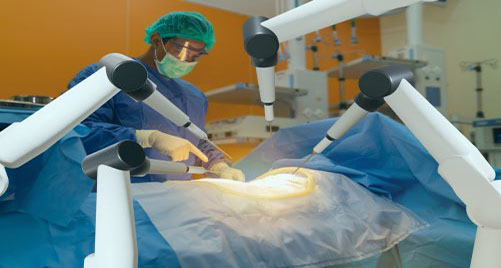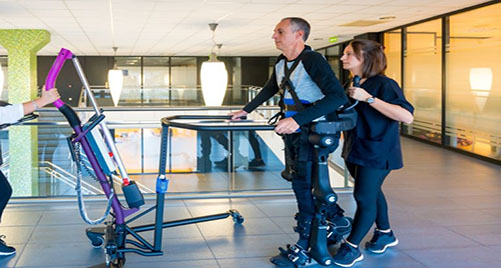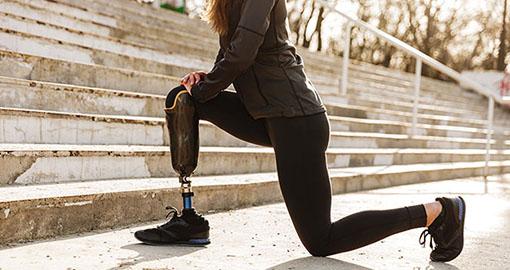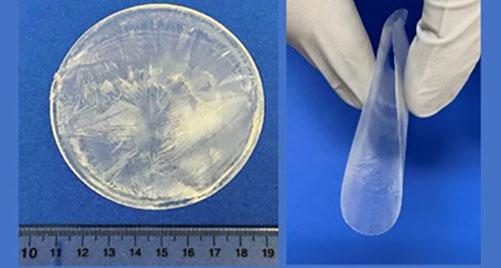- What are robotic medical devices?
- What are the benefits of robotic medical devices and how are they being used?
- What are NIBIB-funded researchers developing in the area of robotic medical devices to improve medical care?
- What are bionic medical devices?
- What are the benefits of bionic medical devices and how are they used?
- What are NIBIB-funded researchers developing in the area of bionic medical devices to improve medical care?
What are robotic medical devices?
Robotic medical devices are “smart” machines that can perform actions that a health care provider might. These devices incorporate principles from several academic disciplines, including engineering, computer science, mathematics, and medicine.
Some robots can operate by themselves without any outside control. Others operate with some monitoring or control by a person, while others are fully controlled by a person.
Robotic systems have many applications in medicine including surgery, endoscopic procedures (to look inside a hollow cavity or organ), and physical rehabilitation to help people recover from an injury or disorder.
What are the benefits of robotic medical devices and how are they being used?
They can perform minimally invasive surgery. Patients benefit from robotic tools that make tiny incisions. This can lower the risk of infection and cause less tissue damage and blood loss. Also, patients may need less pain medication and have a quicker recovery time.

Surgeons benefit from operating robotic arms and surgical instruments from a console, which eases the physical strain of long procedures. Another advantage is that robotic arms can be equipped with attachments. These include microgrippers—tiny magnetic claws—that make surgical procedures more precise and robotic cameras that provide surgeons with high-definition 3D views of the body while performing procedures.
Robots can be used to help with different types of surgery. For example, in reproductive surgery, they can help with removing and repairing reproductive organs such as removing the uterus (hysterectomy), ovaries, or the prostate gland, and treating gynecological problems such as pelvic organ prolapse and fibroids.
They can perform minimally invasive endoscopic procedures that use a flexible tube-like tool called an endoscope. Robots can help physicians treat early-stage tumors in the gastrointestinal tract by increasing precision when removing cancerous tissue and minimizing damage to healthy tissue. Robotic endoscopy systems equipped with sutures can also close small openings in the gut after tissue removal.
They can be worn as exoskeletons that provide support, strength, and mobility to the user. These exosuits are used to help people with limb loss in rehabilitation. The devices can be worn over a patient’s legs, arms, or entire body and are powered with battery packs or other sources of energy, enabling users to initiate and control standing up, sitting down, standing, and walking.

Being able to stand and walk in an upright position can help people with spinal cord injuries prevent health complications, such as rigid muscles, impaired bowel function, and other conditions that reduce quality of life.
Increasingly, robotic exoskeletons are made from soft material and elastic parts that are lightweight, flexible, compliant, and more comfortable than rigid materials, which can be bulky and heavy to wear. The soft material reduces the risk of injury to the wearer and allows for safer human interaction.
What are NIBIB-funded researchers developing in the area of robotic medical devices to improve medical care?
A self-driving needle steers through living lung tissue
The lungs are one of the most difficult organs for physicians to navigate. They have a dense network of blood vessels, bronchi, and other critical anatomical structures that makes reaching distant lung nodules with a conventional bronchoscope challenging. To overcome these limitations, researchers have built a compact semi-autonomous robotic system that can steer a flexible needle around these anatomical obstacles within the lungs of live animals. The robot could someday be used to biopsy the smallest clinically relevant nodules more safely and with better outcomes for patients.
A shape-shifting robotic catheter could make heart surgery safer

A significant share of cardiac procedures performed in the U.S. are open-heart surgeries, which entail extensive recovery periods and aren’t safe for some high-risk patients.
A new robotic catheter could someday equip surgeons to operate in the cardiac environment with greater ease. The device has shape-shifting capabilities that allow it to be maneuvered through complex anatomy while maintaining enough stability to accomplish surgical objectives within the heart. With further development, the robotic catheter could make many common heart surgeries far safer and less taxing on the body.
Researchers aim to streamline brain surgery with a new soft robotic system
Navigating the labyrinthine vasculature of the brain with standard surgical instruments can be incredibly challenging, even for the steadiest of hands. But with some robotic assistance, brain surgeons could potentially operate with far greater ease.
Researchers have laid the groundwork for a soft robotic tool and control system that could grant surgeons an unprecedented degree of maneuverability within the brain. With further development, the robot could one day speed up and improve the efficacy of minimally invasive surgeries for life-threatening brain aneurysms and other serious conditions.
What are bionic medical devices?
They are high-tech devices that can restore or improve physical abilities that were partially or fully lost due to injury or disease. These devices are designed to mimic or replace natural functions such as walking or hearing.
What are the benefits of bionic medical devices and how are they used?
They can increase mobility and functioning in people who have lost their limbs or the use of them. Artificial limbs are becoming increasingly

lifelike due to advanced technology, such as sensors that measure angles and forces while a person walks and a computer chip (microprocessor) that uses that information to enable the user to control the position and motion of their artificial limb(s).
They can partially restore functioning to people with hearing or vision loss. For example, surgically implanted electronic hearing devices (cochlear implants) can benefit people with little to no hearing. The devices electrically stimulate the nerves inside the ear, sending signals to the brain that are interpreted as speech and sound.
Another implanted electronic device can partially restore vision in patients whose retina—a thin, light-sensitive tissue at the back of the eye—has deteriorated. The device, known as a retinal prosthetic, works by processing incoming light and transmitting the information through electrical impulses to the remaining inner retinal layers.
What are NIBIB-funded researchers developing in the area of bionic medical devices to improve medical care?
Neurally controlled prosthetic ankle allows for intuitive balance correction
Roughly two million people living in the United States have had an amputation, and amputations of the lower limbs are the most common. Many individuals will choose to use an artificial (prosthetic) device to assist in walking.
NIBIB-funded researchers have developed an ankle prosthetic that relies on the user's residual muscle to generate electrical signals to help amputees maintain ongoing control of their posture and balance.
Engineers harness muscle power for healing
Bioengineers have developed an implantable device that can generate electrical impulses when the material is flexed by muscles moving and

contracting. This wafer-thin technology has the potential to enable the broad use of therapies that combine electrical and mechanical properties.
The device uses “piezoelectric” materials that can self-assemble and create an electrical charge during mechanical stress. These materials have been used in medicine for ultrasound imaging and for electrostimulation, which can accelerate the healing of wounds and bone fractures, maintain muscle tone in stroke victims, and reduce chronic pain.
